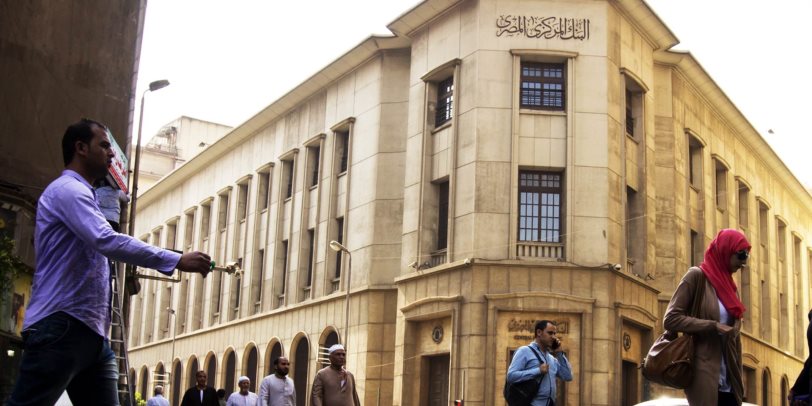Egyptian banking sector's domestic liquidity surges to EGP 8.06tr, indicating strong financial health
Egypt's banking sector is on a path of growth and stability as domestic liquidity reaches EGP 8.06 trillion, marking a significant increase.
 The rise in money supply and currency circulation highlights the sector's robust performance — Photo illustrated by Business Today Egypt
The rise in money supply and currency circulation highlights the sector's robust performance — Photo illustrated by Business Today Egypt
Egypt's domestic liquidity in the banking sector reached EGP 8.06 trillion by the end of April 2023, compared to EGP 7.402 trillion at the end of December 2022, marking an increase of EGP 666.410 billion.
The Central Bank revealed in a recent report that the money supply rose to EGP 1.904 trillion, up from EGP 1.739 trillion at the end of last December.
Meanwhile, currency in circulation outside the banking system amounted to EGP 926.677 billion by the end of April, compared to EGP 831.2 billion at the end of December 2022.
Reports indicate that demand deposits in local currency reached EGP 977.895 billion, up from EGP 908.3 billion at the end of the previous year, while quasi-money stood at EGP 6.164 trillion.

Local liquidity’s vital role:
Local liquidity plays a vital role in affirming the banks' ability to meet their financial obligations, primarily by fulfilling depositors' withdrawal requests and borrowers' needs.
It is defined as the total cash flows or available cash balances that enable a bank to meet its obligations immediately, either by holding liquid cash reserves or by quickly converting its assets into liquid cash without losing their value.
Local liquidity plays a crucial and vital role that banks play in supporting various economic sectors, as well as national projects, which ultimately have a positive impact on economic growth rates.
Egypt's banking sector has witnessed significant growth in recent years, with improved liquidity levels and robust financial performance.
The increase in domestic liquidity to EGP 8.06 trillion by April 2023 reflects the resilience and stability of the banking system.

CBE’s exerting efforts to boost liquidity:
The Central Bank's efforts to enhance liquidity management and promote economic growth have contributed to these positive outcomes.
The rise in money supply and currency circulation demonstrates the confidence of depositors and investors in the Egyptian banking sector.
This solid foundation positions Egypt's financial industry as a key player in driving economic development and supporting various sectors through financing and investment opportunities.

Commitment and strategy:
The Central Bank of Egypt has been diligently working to boost liquidity within the country's banking sector. Recognizing the vital role liquidity plays in supporting financial stability and economic growth, the CBE has implemented various measures and initiatives to enhance liquidity management.
One of the key strategies employed by the CBE is the management of money supply. By carefully monitoring and adjusting the amount of money circulating in the economy, the central bank aims to maintain an optimal level of liquidity. This involves striking a balance between ensuring sufficient cash flow for economic activities and preventing excessive inflationary pressures.

Hassan Abdullah, the Acting Governor of the Central Bank, stated that the valuation of the Egyptian pound in relation to various foreign currencies will be determined based on the principles of supply and demand.
In addition to managing money supply, the CBE has actively engaged in liquidity injection operations. These operations involve providing liquidity to banks through various mechanisms such as repo agreements, open market operations, and discount windows. By supplying banks with additional funds, the CBE ensures that they have adequate resources to meet their financial obligations and support lending activities.
Furthermore, the CBE has implemented effective liquidity monitoring frameworks and tools. By closely monitoring liquidity indicators and market dynamics, the central bank can promptly identify any potential liquidity shortages or imbalances. This allows for proactive interventions and the implementation of appropriate measures to maintain stability and address any liquidity challenges.

Yielding positive results:
The CBE's efforts to boost liquidity have yielded positive results, with increased domestic liquidity levels observed in recent years.
This enhanced liquidity provides banks with the necessary resources to meet depositor demands, support lending activities, and drive economic growth. It also instills confidence in the banking system and contributes to overall financial stability within the country.
The central bank's commitment to liquidity management and its proactive approach in ensuring adequate funding for banks have garnered recognition both domestically and internationally.
The CBE's efforts have positioned Egypt's banking sector as a resilient and stable entity, capable of effectively managing liquidity challenges and supporting the country's economic development.
In conclusion, the Central Bank of Egypt's continuous efforts to boost liquidity in the banking sector has played a crucial role in maintaining financial stability and supporting economic growth.
Through strategic liquidity management, injection operations, and vigilant monitoring, the CBE has successfully enhanced liquidity levels, providing banks with the necessary resources to fulfill their obligations and contribute to the country's progress.





